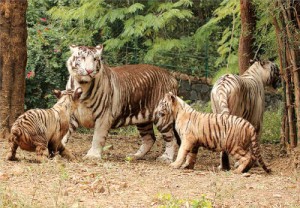 The white tigress and her cubs at the Vandalur Zoo.
The white tigress and her cubs at the Vandalur Zoo.
An early report after the inauguration, states, “The first task was to enrich the animal collection of the zoo and the highest priority was given to acquisition of glamorous exotic animals from different parts of the globe. Breeding of the rare and endangered species of wild animals, like Sangai (Thamin deer), Swamp Deer, Lion-tailed Macaque, Nilgiri Langur, Indian Gaur, Wild Dog, Indian Tiger and the Asiatic Lion, was successful. Avian species that bred successfully included the Pea Fowl, Red Jungle Fowl and Kaleej Pheasant. The Rock Python and the rare Malabar Squirrel, endemic to the Western Ghats, have also bred well.”
By 1986, battery-operated vehicles had been introduced for visitors, and a vehicle parking area added. The State Transport Corporation arranged for bus terminals at the Zoo campus.
In October 2, 1989, Chief Minister M.G. Ramachandran, while inaugurating the Wildlife Week celebrations, also opened to the public four newly constructed enclosures: Lion Safari, Walk-through Aviary, Reptile House and Nocturnal Animal House. And Dr. M.S. Swaminathan, on a visit in 1990, noted, “This is a unique zoo not only with reference to the area covered but also with regard to the imagination and dedication displayed in planning the zoological garden and making the animals feel happy.” With the Central Zoo Authority (CZA), a statutory body of the Ministry of Environment and Forests, established in 1992 to oversee the functioning of zoos, the Vandalur Zoo was accorded formal recognition, with renewal to be sought from the CZA once in three years.
 The hippo with its calf at the Vandalur Zoo.
The hippo with its calf at the Vandalur Zoo.

The Aquarium at the Zoo in the shape of a shark.
By 1996, an additional breeding house for the Tigers and a watch tower for visitors in the Lion Safari Park had been constructed. The Otter House, Giraffe House and Giant Squirrel House were proving popular attractions. With the Central Government ban on the training and exhibition of five species of animals, viz Tiger, Lion, Panther, Bear and Monkey, in 1998, a Rescue and Rehabilitation Centre was established the following year and additional cells were constructed for rescued animals. By 1999, an Aquarium in the shape of a shark, with 21 fish tanks, was in place with entry through the simulated gills! A rat and mice rearing centre was created in a first attempt towards mass production of rats and mice to feed the snakes.
In 2000, a Rescue and Rehabilitation Centre for circus animals was established at the Zoo. Also a facility for housing the birds received from the public/animal welfare organisations and a convalescing yard in the Zoo Hospital to provide movement space.
In 2003, a 30 ha Deer Safari area was created adjoining the Lion Safari. By 2004, the Zoo had a new entrance on the GST Road. That year, the Zoo Authority of Tamil Nadu was formally registered as a Society for better management of the Aringar Anna Zoological Park (AAZP) and for monitoring use of the funds released by the CZA.
By the early 2000s, the crowds warranted as many as 30 ticket counters on a festive occasion like Kaanum Pongal! Counters were even operated in bus terminals in various parts of the cities like Koyambedu, Avadi, Ambattur, Broadway, Tambaram, Mandaveli, and Guduvancherry! On an average day, 5,000 footfalls are recorded, and on the weekends around 20,000.
It is recorded that 20,02,545 visitors visited the Zoo during 2011-12 and Rs. 5.15 crore revenue was collected. By 2014-2015, the crowds had swelled to 23, 82, 625!
At present, the Vandalur Zoo houses 170 species – mammals, birds and reptiles, housed in 85 enclosures. Of these, 45 are endangered. It has also the highest number of animals exhibited across India – 2142 in all!
One of the biggest zoos in Southeast Asia, it extends over an area of 602 ha. The daily intake of its inmates include 190 kg of food grains, 320 kg of vegetables and fruits, 750 kg of beef and fish, 430 kg of cattle feed and 2000 kg of green fodder.
Based on modern concepts of zoo design and spread over 510 ha. of dry evergreen forests with gentle undulating terrain, the specially created open island type enclosures with hidden walls and simulated natural environments help the animals, birds and reptiles to experience their natural environment. Attractive, life-size wall exhibits entice passers-by with a glimpse of what the campus can showcase in terms of biodiversity.
Crowd-pullers are the Carnivore enclosures for the Lions and Tigers, particularly the White Tiger, that was acquired seven years ago, and whose numbers have risen to 12 –the King Cobra and the Neer Yanai or Hippo.
“During one meal, an adult tiger consumes about 7 kg of meat! Once a week, he gets a chicken meal for a change and Tuesday is a day of fasting!” says zookeeper Parthiban. Meanwhile, ten-year-old Ramu prowls around his enclosure with other males, all competing for the attention of the lionesses around! The average cost of feeding a lion or a tiger for a week is Rs. 4,500. The Zoo invites sponsors who would like to pay for the food for lions, tigers or any other animal for a day/week/month/year.
(To be continued)